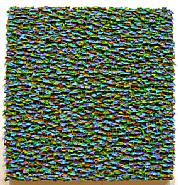
|
||
|
Portland art blog + news + exhibition reviews + galleries + contemporary northwest art
|
||
AFF New York by Brad Carlile  Robert Sagerman's 5,460 @ Margaret Thatcher Projects The AAF Contemporary Art Fair was this past weekend at New York's Pier 92. There was art from 140 galleries including three from Portland:Butters Gallery, PDX Contemporary Art, and Alysia Duckler Gallery. The tag line was "Fine Art under $10,000". Previously they used to advertise "affordable art under $5,000" -- that's inflation I guess. If you must, a few postage-stamp sized works at $100 did exist. I was hoping to see some fresh work, but didn't find much. A problem with an art fair like this is that most galleries seemed to hang slightly-stale decorative works. However, a saving grace for me, the AAF was less loaded with adolescent images on paper than The Affair @ the Jupiter hotel (sorry, but I overload easily on this type of work). At London's Quantum Gallery, Diane Kaufman's impasto portraits were quite gripping (and selling). These thick layered oils start with a Baconesque feel andthen go further. Fleshy cuts of the palette knife descend through multi-color strata to reveal both turmoil and humanity. They also ask why we invest such meaning in a face's configuration. Also in the thick paint category is Robert Sagerman's richly textured work at Margaret Thatcher Projects (New York). Robert Sagerman's brightly-colored work dizzyingly captures one's wholeperipheral vision. The web images don't do it justice, but in-person one wants to dive into the spaces and gaps in between. Soon one is exploring more dimensions than even string theorists need. Paintings are named after the number of palette strokes (another example is 33,868). At Yellow Bird Gallery (Newburgh NY) was a delightful work by TODT, a long-standing four-person collaborative. In TODT's "Battleship America" the deck is the outline of the US and battleshipturrets fill nearly every space with guns poised in every direction. In the areaknown as Texas, a white car is being gassed up and "off the starboard bow" ananchor is attached to Florida. At another UK gallery, Byard Art (Cambridge), Chris Wood's dichromatic sandblasted glass creates a complex dance of light that would be perfect for our northwest winters. I look forward to seeing where she goes next. As Jeff Jahn has noted the Portland art scene has a lot going for it. But sometimes one should sample 140 galleries just to check this assumption. Our scene holds up well.  Trish Grantham @ Museum Works Gallery Another New York gallery that caught my attention was the Museum Works Galleries (Aspen, New York, LA) where I spied the work of Portland's own Trish Grantham. Robert Casterline, the gallery owner, proudly told me that he just signed an exclusive with her. He told me, "you're going to see a lot more from her, she's from O-ree-gone" Yep, golly we do live in one of them far-flung unpronounceable provinces. As mentioned earlier, three of Portland's galleries were at the AAF Contemporary Art Fair.Each had a fine display of works familiar to Portlanders. I mainly stopped by to say, "hi." I hope that the four-day fair was good to our quality galleries. That night, over several manhattans (nothing to do with were I was, just a decade-long fav) I related the art I saw and the current high-caliber of Portland's scene to an ex pat Portlander. I am so glad I don't live in those far-too-common low-caliber provinces. Checking Chelsea Another afternoon was spent wondering around Chelsea. At the Stefan Stux Gallery two of Young Sun Lim's installations were gripping. "Dong Chan - Pale Blue Moon" is a statement on individuality in society. It consists of 170 life-sized carved wooden heads that move randomly knocking into each other and produce these wonderfully eery sounds. The second was "Room of the Host 2" where 200 glass jars filled with embryotic babies float in a lit oily environment supported by electronics to sense, blink, twist, and sound offin response to the movement of visitors. Thought provoking and well worththe visit. Though I fear if I had to work in that gallery for a month that my psyche would be permanently scarred. At the Von Lintel Gallery is Joseph Stashkevetch's large-scale drawings on rag paper that capturea balance between softness and sharp imagery. His work strikes such a note of clarity when contemplated at a distance. A final Chelsea visit of note was to Brian Clamp's ClampArt.Brian Finke's photographs of male and female body builders have such color and luminance that they seem to be transparencies on light boxes. New Yorkers demand quality in so many things but, as my friend confirmed, they seem to lack taste in an important area that Portland excels (coffee)...so I'm coming back to start my morning with some finely-roasted beans. Brad Carlile is a photographer based in Portland Posted by Guest on November 04, 2005 at 0:30 | Comments (3) Comments Thanks for the report Brad. The AAF provokes a lot of discussion amongst artitsts everywhere... mostly due to the "affordable" moniker. A lot of artists have issue with fairs to begin with and this moniker makes them feel even more uneasy. Many worry it is creating a "blue light special" mentality and AAF is hardly the only fair that bothers them. Do fairs like this really cater to the die hard collectors or are they primarilly entry points for newer or more sporadic collectors? Yes and no, many very serious collectors do hit this fair but I dont think that is AAF's target. Fairs like A.B. Miami, Basel, Frieze and maybe the Armory show are for more serious collectors who are in all out competition for the cutting edge. Still, there is a place for art fairs and it isnt all crass commerce, there is a kind of leveling that happens when gallereies have to leave their great to terrible spaces. Lastly, in comparison to many other fairs AAF certainly isn't a pulse quickener either. I've never considered traveling to one for the sake of just the fair, there always needed to be a museum show in the same city that I really wanted to see. Posted by: Double J I thinks fairs like this do serve some purpose, and I, like you, won't (and didn't) travel to one to see one. ...but if it is in town, sure. As you'd suspect, there was a mix at the AAF: a few serious collectors, more sporadic collectors, and some finding a piece of art to match the couch. As has been discussed in a variety of places, Portland needs more serious collections. But I wonder, does Portland have a much greater need to foster more newer and to increase the number of sporadic collectors? What does Portland need to make that happen? Won't Portland develop more serious collectors if they stood above a broader base? I'm not just talking about this in the crass commercial "fill the pipeline terms", but in terms of building the widespread influence of art and discourse about art in Portland Posted by: bradc Yes, but i am going to Maimi (and other fairs) as a desitination, AAF lacks that kind of "pull". Your questions about collectors is pretty spot on. The secret about Portland is that is does have a very broad collector base already (Ive heard Bob Kochs at Augen say this too). It's why we have so many galleries here. Problem is who are the big name collectors? (I suggest anyone curious about that take a tour of the new Jubitz center at the museum for some answers). Still, there needs to be one or two people who really decide to be very public collectors in Portland. Obviously, Sarah Meigs and Ed Cauduro have proven themselves with the Agnes Martin and Warhols, etc. that they have collected. Still, I think the most interesting collectors are the ones who find artists even before the galleries do... see this article. Collecting is a big question in Portland because the artists are in many cases more progressive than the collector pool (as a generalization). In those cases (like David Eckard) artists end up doing residencies in France. Portland is a kind of rebel base for artists... as far as its relationship to rebel collecors that remains to be seen. Posted by: Double J Post a comment Thanks for signing in, . Now you can comment. (sign out)
(If you haven't left a comment here before, you may need to be approved by
the site owner before your comment will appear. Until then, it won't appear
on the entry. Thanks for waiting.)
|
| s p o n s o r s |
 |
 |
 |
 |
 |
 |
 |
 |
 |
 |
 |
 |
 |
 |
 |
 |
 |
 |

|
Site Design: Jennifer Armbrust | • | Site Development: Philippe Blanc & Katherine Bovee | |


![[TypeKey Profile Page]](http://www.portlandart.net/nav-commenters.gif)